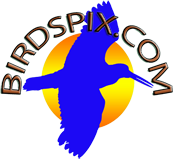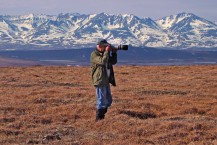On April 7 I flew to Denver to meet up with the Sunrise Birding group led by Connecticut’s Gina Nichol, England’s Steve Bird, and Arizona’s Wezil Walraven for a ten-day circuit of Colorado focused primarily, though not entirely, on searching for game bird species. I hoped to add up to five new species to the birdspix.com list. The ambitious itinerary led us to all four quadrants of the state and covered a total of 2243 miles. A total of 140 species were logged (135 seen and 5 heard only), certainly not all of which are recounted here. All the group’s many target species were logged with the sole exception of Pinyon Jay.
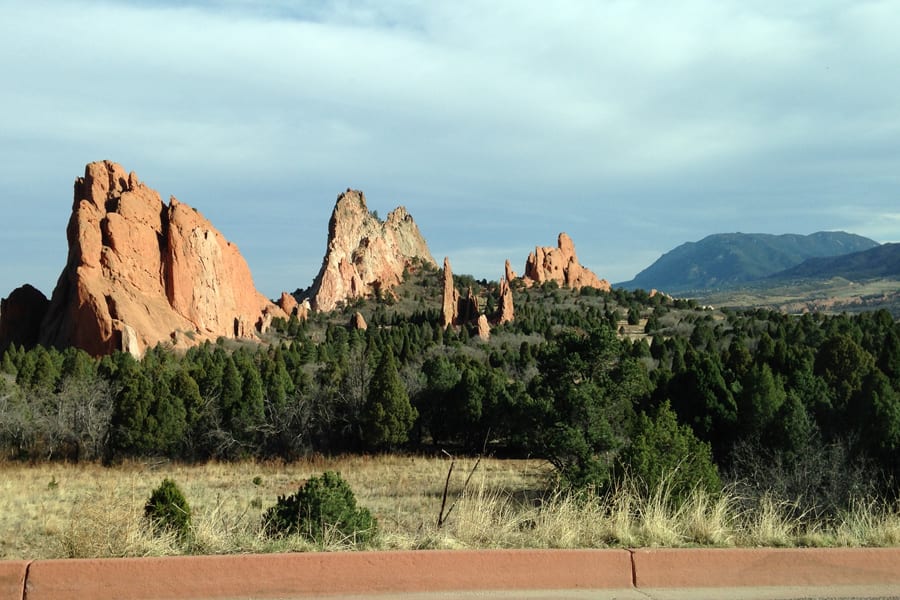 From Denver airport on the way southeast to overnight in Pueblo, we visited scenic Garden of the Gods in Colorado Springs, where on the cliffs glowing red in the evening sunlight we scoped a Prairie Falcon high up on the rock wall and watched numerous White-throated Swifts darting erratically over the promontories.
From Denver airport on the way southeast to overnight in Pueblo, we visited scenic Garden of the Gods in Colorado Springs, where on the cliffs glowing red in the evening sunlight we scoped a Prairie Falcon high up on the rock wall and watched numerous White-throated Swifts darting erratically over the promontories.
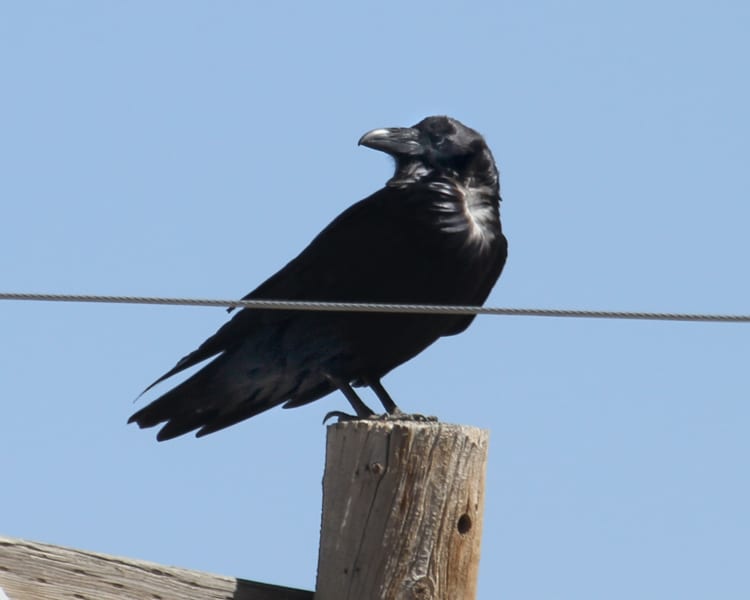 April 8 – day two: Morning featured, among other species in the Pueblo environs, a scattered covey of Scaled Quail between the road and a residential neighborhood, and a stop at Holbrook Reservoir found numerous ducks and grebes including a Clark’s Grebe, Snowy Plovers, Long-billed Curlews, American Avocets, Marbled Godwits, and even a small flock of Franklin’s Gulls. Outside of nearby La Junta we had a Chihuahuan Raven perched on a pole with
April 8 – day two: Morning featured, among other species in the Pueblo environs, a scattered covey of Scaled Quail between the road and a residential neighborhood, and a stop at Holbrook Reservoir found numerous ducks and grebes including a Clark’s Grebe, Snowy Plovers, Long-billed Curlews, American Avocets, Marbled Godwits, and even a small flock of Franklin’s Gulls. Outside of nearby La Junta we had a Chihuahuan Raven perched on a pole with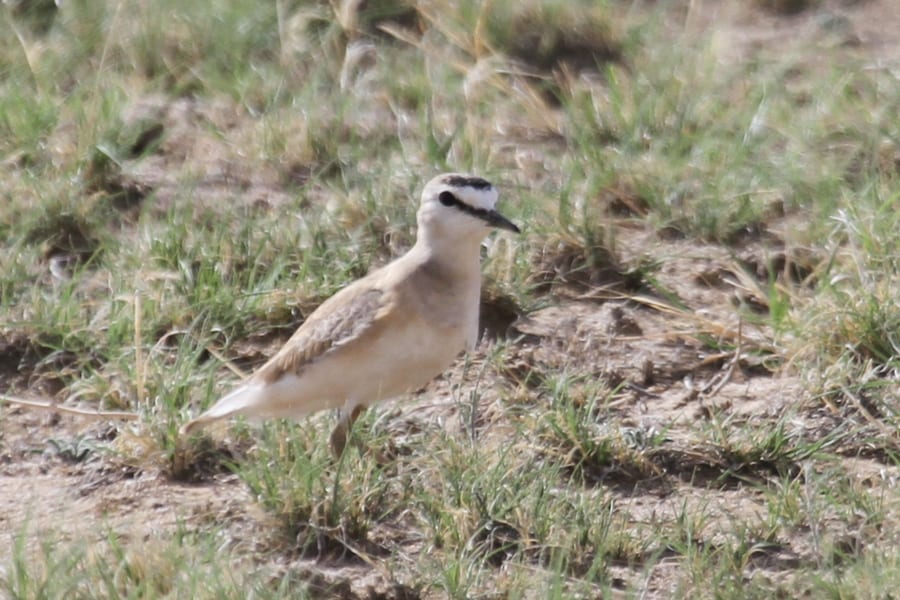 the stiff wind nicely fluffing up its signature white neck feathers which are not usually easily seen. Finally, along the road not far from Adobe Creek Reservoir, the first of my five sought-after species, a pair of delicately-colored Mountain Plover (1) on the sparsely covered open ground – a particularly gratifying find since this uncommon bird was the one species I had managed to miss at Pawnee National Grasslands on a previous visit to Colorado in 2010.
the stiff wind nicely fluffing up its signature white neck feathers which are not usually easily seen. Finally, along the road not far from Adobe Creek Reservoir, the first of my five sought-after species, a pair of delicately-colored Mountain Plover (1) on the sparsely covered open ground – a particularly gratifying find since this uncommon bird was the one species I had managed to miss at Pawnee National Grasslands on a previous visit to Colorado in 2010.
April 9 – day three: After overnight in Lamar, we rose at 3:40 AM for the first of our planned early-morning lek-viewing outings – this one for the endangered Lesser Prairie Chicken (2), my own second sought-after species. These game birds were once numerous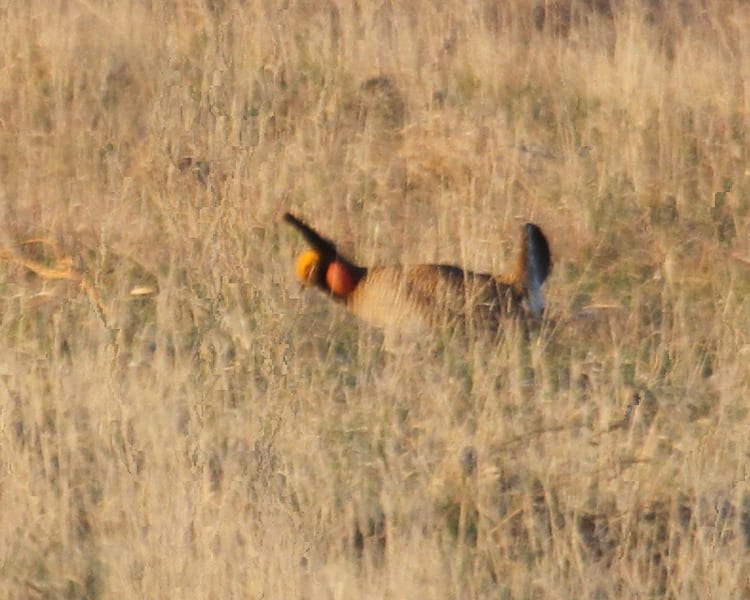 across the plains, but were hunted nearly to extinction during westward expansion in the 1800’s and now can be viewed only by making prior arrangements at one of the few protected “leks” (the grounds where males perform their strange early-morning ritual mating displays trying to outdo one another in impressing an eligible female). Viewing all this entails a ritual of its own. The viewing is done entirely from a blind, inside which one must remain perfectly quiet. One has to be on site in the blind before the birds begin their dance (i.e while it is still pitch dark), and one is not permitted out of the blind (no bathroom break) until the birds are done (usually about an hour after sunrise).
across the plains, but were hunted nearly to extinction during westward expansion in the 1800’s and now can be viewed only by making prior arrangements at one of the few protected “leks” (the grounds where males perform their strange early-morning ritual mating displays trying to outdo one another in impressing an eligible female). Viewing all this entails a ritual of its own. The viewing is done entirely from a blind, inside which one must remain perfectly quiet. One has to be on site in the blind before the birds begin their dance (i.e while it is still pitch dark), and one is not permitted out of the blind (no bathroom break) until the birds are done (usually about an hour after sunrise).
This Lesser Prairie Chicken lek is on private land owned by Norma and Fred Dorenkamp of Holly, CO. Fred met up with our group in the dark at our prearranged location and transported us to the lek in his old yellow school bus which then doubled as our blind, out the open windows of which we would be able to view, scope, and photograph the birds – which as it turned out were actually not that close but some seventy-five yards away. It was very cold, but the early morning was clear, the sunrise lighting just fine, and life was all good. Fred and Norma then topped everything off with a hearty chuck wagon style breakfast for us in their memorabilia room which featured many antique wild west implements and some of Fred’s old rodeo equipment from his days as a bronc rider.
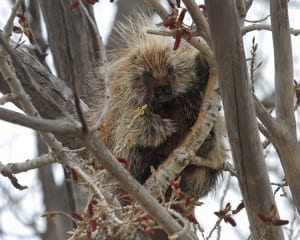 After packing up back at the hotel, the rest of this day consisted mainly of travel from Colorado’s southeast corner to Wray in the northeast corner. We stopped at Bonny Lake State Wildlife Area, but there’s no longer a lake there – just an old dam and a dry lake bed, but we did get an unusual close-up study of a pair of Porcupines there, one (whose wizened look reminded me of Yoda) nestled in a tree, and the other huddled partially concealed in a brushy tangle on the ground.
After packing up back at the hotel, the rest of this day consisted mainly of travel from Colorado’s southeast corner to Wray in the northeast corner. We stopped at Bonny Lake State Wildlife Area, but there’s no longer a lake there – just an old dam and a dry lake bed, but we did get an unusual close-up study of a pair of Porcupines there, one (whose wizened look reminded me of Yoda) nestled in a tree, and the other huddled partially concealed in a brushy tangle on the ground.
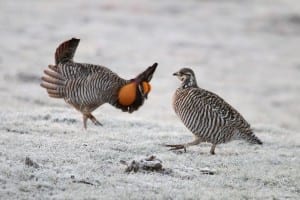 April 10 – day four: Again we were up in the dark to visit another lek – this one for Greater Prairie Chicken (3) – my third target species – on the private land of Bob Bledsoe, and again by prior arrangement. Bob has outdone himself providing an outstanding viewing opportunity for his visitors by permanently parking two vehicles (one of which is a showroom-new four-door pickup truck) on the lek itself such that the birds are able to be viewed very close-up on either side of the vehicles. The morning was freezing cold, necessitating long underwear, multiple clothing layers, hats, gloves, etc., and we first had to scrape the frost off the vehicles’ windows. The fact notwithstanding that one’s bladder always seems to call attention to itself most emphatically when there is no opportunity to go, boy was this ever the show! First of all the displaying chickens produce this other-worldly eerie musical wavering which is called “booming,” (video) but which actually sounds more like continuous blowing across the mouths of many distant soda bottles. Then the chickens were so close that a few times I had to zoom out on the camera lens just to get the whole bird into the frame, and a few times birds actually landed on the roof of the vehicles. We counted some thirty-one Greater Prairie Chickens here.
April 10 – day four: Again we were up in the dark to visit another lek – this one for Greater Prairie Chicken (3) – my third target species – on the private land of Bob Bledsoe, and again by prior arrangement. Bob has outdone himself providing an outstanding viewing opportunity for his visitors by permanently parking two vehicles (one of which is a showroom-new four-door pickup truck) on the lek itself such that the birds are able to be viewed very close-up on either side of the vehicles. The morning was freezing cold, necessitating long underwear, multiple clothing layers, hats, gloves, etc., and we first had to scrape the frost off the vehicles’ windows. The fact notwithstanding that one’s bladder always seems to call attention to itself most emphatically when there is no opportunity to go, boy was this ever the show! First of all the displaying chickens produce this other-worldly eerie musical wavering which is called “booming,” (video) but which actually sounds more like continuous blowing across the mouths of many distant soda bottles. Then the chickens were so close that a few times I had to zoom out on the camera lens just to get the whole bird into the frame, and a few times birds actually landed on the roof of the vehicles. We counted some thirty-one Greater Prairie Chickens here.
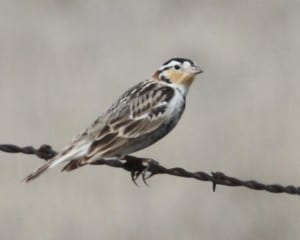 After packing up back at the hotel, and shedding a layer or two, next stop was the Pawnee National Grasslands area where we had Chestnut-collared Longspur just south of the Grasslands themselves along CR 105, and
After packing up back at the hotel, and shedding a layer or two, next stop was the Pawnee National Grasslands area where we had Chestnut-collared Longspur just south of the Grasslands themselves along CR 105, and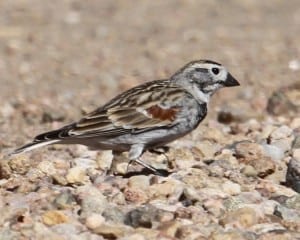 McCown’s Longspur at precisely the same spot where I saw them in July, 2010 along the Grasslands’ main marked birding route. Then we drove southwest, skirting Denver and heading up into the Rockies with the night at Silverthorne at elevation 8,970 ft.
McCown’s Longspur at precisely the same spot where I saw them in July, 2010 along the Grasslands’ main marked birding route. Then we drove southwest, skirting Denver and heading up into the Rockies with the night at Silverthorne at elevation 8,970 ft.
April 11 – day 5: First stop this morning was a hillside residential neighborhood to stake out a feeder where all three species of Rosy-Finches were possible. We spotted a sizable flock of Rosy-Finches almost right away, but the yard with the feeder was now festooned 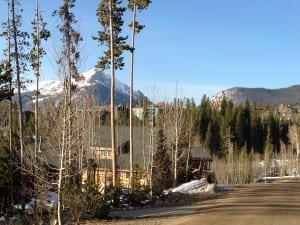 with signs warning away any binoculars, telescopes, photography, or even so much as an approach. Apparently the woman owner had had a run-in with another birding group earlier in the week which had now spoiled things for everyone else. We were careful to remain well away from that house, but with patience still managed to get good views of mostly Brown-capped and a few Gray-crowned Rosy-finches, and even one Black was briefly seen – a life bird for several in the group. Gray Jay, Steller’s Jay, Mountain Chickadee, and Pygmy Nuthatch were around, and there was also a treetop view of a small group of Pine Grosbeaks.
with signs warning away any binoculars, telescopes, photography, or even so much as an approach. Apparently the woman owner had had a run-in with another birding group earlier in the week which had now spoiled things for everyone else. We were careful to remain well away from that house, but with patience still managed to get good views of mostly Brown-capped and a few Gray-crowned Rosy-finches, and even one Black was briefly seen – a life bird for several in the group. Gray Jay, Steller’s Jay, Mountain Chickadee, and Pygmy Nuthatch were around, and there was also a treetop view of a small group of Pine Grosbeaks.
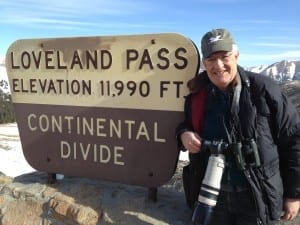 From here it was over to Loveland Pass at an elevation of nearly 12,000 feet to look for White-tailed Ptarmigan, difficult to spot because of its perfect white winter camouflage against the snow. It took a while, with panning through all the scopes, before one was finally spotted, two
From here it was over to Loveland Pass at an elevation of nearly 12,000 feet to look for White-tailed Ptarmigan, difficult to spot because of its perfect white winter camouflage against the snow. It took a while, with panning through all the scopes, before one was finally spotted, two 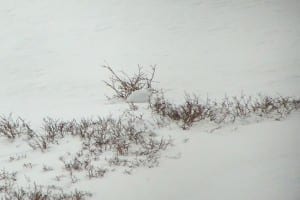 hundred yards away – nothing more than a small roundish white shape with a dark eye and short dark bill. It was interesting seeing the species in its white basic plumage, but unfortunately a far cry from the close-up views I had lucked upon of the species in its speckled alternate summer plumage at Medicine Bow Curve in Rocky Mountain NP in July, 2010.
hundred yards away – nothing more than a small roundish white shape with a dark eye and short dark bill. It was interesting seeing the species in its white basic plumage, but unfortunately a far cry from the close-up views I had lucked upon of the species in its speckled alternate summer plumage at Medicine Bow Curve in Rocky Mountain NP in July, 2010.
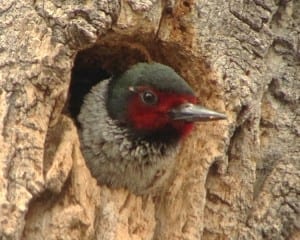 Finally, heading on westward toward Gunnison, we made a stop in a neighborhood in Buena Vista for two Lewis’s Woodpeckers, resplendent as usual in their unique dark green and bright pink plumage.
Finally, heading on westward toward Gunnison, we made a stop in a neighborhood in Buena Vista for two Lewis’s Woodpeckers, resplendent as usual in their unique dark green and bright pink plumage.
April 12 – day 6: With Gunnison as a two-night base, several venues today produced at least five American Dippers in the rushing water at Almont, more Brown-capped Rosy-Finches and some Cassin’s Finches in Crested Butte, and at the Gunnison National Forest Townsend’s Solitaire and a surprise pair of American Three-toed 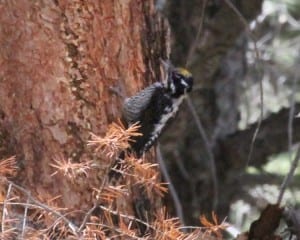 Woodpeckers. Above the Blue Mesa Dam there were unusual eye-level views of White-throated Swifts, and an exquisite sky-blue Mountain Bluebird posed cooperatively on a chain link fence. That evening we had what I considered the trip’s best dinner at Garlic Mike’s in Gunnison. The shrimp scampi was memorable and it had some special ingredient that gave it a spicy kick, but although I made it a point to ask Mike wouldn’t divulge the secret…
Woodpeckers. Above the Blue Mesa Dam there were unusual eye-level views of White-throated Swifts, and an exquisite sky-blue Mountain Bluebird posed cooperatively on a chain link fence. That evening we had what I considered the trip’s best dinner at Garlic Mike’s in Gunnison. The shrimp scampi was memorable and it had some special ingredient that gave it a spicy kick, but although I made it a point to ask Mike wouldn’t divulge the secret…
April 12 – day 7: Another 3:30 AM alarm clock for a predawn lek vigil, this time for one of North America’s rarest and most protected birds – the Gunnison Sage-Grouse (4), a life bird for everyone on the trip except our leader Wezil. The Waunita lek some 19 miles east of Gunnison is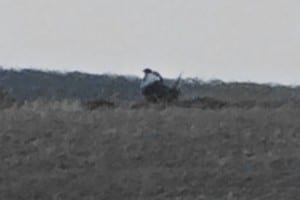 currently the only remaining sanctioned venue for seeing this species, and even this may be discontinued in 2016. Viewing here is from a stationary bus-like blind, and an official observer is present to make certain nothing whatsoever is done to disturb the displaying birds, including leaving the blind, until they are all done – never mind that they are now close to half a mile away on a ridge, having moved further away this season from where they were being seen in prior years. At this distance all viewing was by spotting scope only, but we were able to count twenty-five birds, and it was even possible to digiscope a few pictures – good enough for definitive ID with the unmistakable pony-tail-like filoplume clearly on display. Prisoners in the blind, fortunately no one’s bladder exploded, but there were some pretty desperate faces indeed. Oh, and the temperature this morning was 25 degrees.
currently the only remaining sanctioned venue for seeing this species, and even this may be discontinued in 2016. Viewing here is from a stationary bus-like blind, and an official observer is present to make certain nothing whatsoever is done to disturb the displaying birds, including leaving the blind, until they are all done – never mind that they are now close to half a mile away on a ridge, having moved further away this season from where they were being seen in prior years. At this distance all viewing was by spotting scope only, but we were able to count twenty-five birds, and it was even possible to digiscope a few pictures – good enough for definitive ID with the unmistakable pony-tail-like filoplume clearly on display. Prisoners in the blind, fortunately no one’s bladder exploded, but there were some pretty desperate faces indeed. Oh, and the temperature this morning was 25 degrees.
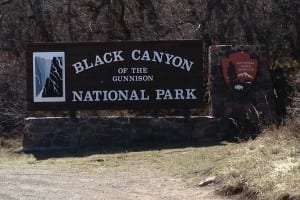 After a replenishing hot breakfast it was on to nearby Black Canyon of the Gunnison National Park, the place for Dusky Grouse – we saw three altogether. No lek behavior
After a replenishing hot breakfast it was on to nearby Black Canyon of the Gunnison National Park, the place for Dusky Grouse – we saw three altogether. No lek behavior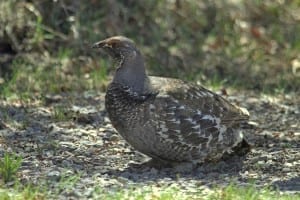 with this species; they are relatively tame, loll in and around the campsites, and do not seem at all fazed by the presence of humans. Next, off to overnight in Grand Junction.
with this species; they are relatively tame, loll in and around the campsites, and do not seem at all fazed by the presence of humans. Next, off to overnight in Grand Junction.
April 14 – day 8: More inspiring scenery at magnificent Colorado National Monument, with lots more White-throated Swifts as well as Rock Wren, Juniper Titmouse, and various 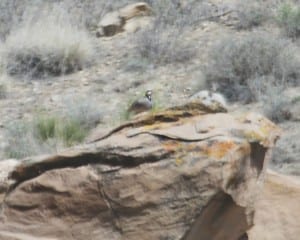 others. Outside of Grand Junction along Coal Creek Canyon Road near Mesa we had our only chance to look for what I hoped would be the fifth new species for me – Chukar (5). This distinctive gray game bird with its black and white face and flanks and red bill favors steep rocky hillsides, and that is exactly where we spotted one – but it dropped down out of sight behind a boulder within seconds after the vans stopped, and had I not luckily fired off a hurried couple of poor shots of this distant bird through the closed van window I would have come away with no record at all. We searched for a little while for another, but besides a momentary sighting by Steve no more Chukars were to be seen by the group here or anywhere else. From here, on to Craig for the night and yet another pre-dawn lek in the morning.
others. Outside of Grand Junction along Coal Creek Canyon Road near Mesa we had our only chance to look for what I hoped would be the fifth new species for me – Chukar (5). This distinctive gray game bird with its black and white face and flanks and red bill favors steep rocky hillsides, and that is exactly where we spotted one – but it dropped down out of sight behind a boulder within seconds after the vans stopped, and had I not luckily fired off a hurried couple of poor shots of this distant bird through the closed van window I would have come away with no record at all. We searched for a little while for another, but besides a momentary sighting by Steve no more Chukars were to be seen by the group here or anywhere else. From here, on to Craig for the night and yet another pre-dawn lek in the morning.
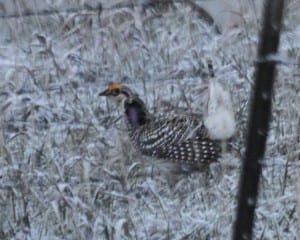 April 15 – day 9: This early morning we used our own vans as the blinds, and with a light dusting of snow on the ground, found some twenty Sharp-tailed Grouse on their lek with most of the birds surprisingly just behind a wire fence directly by the side of the busy highway with huge trucks barreling by at 50 mph. With acres and acres of empty grassy field behind them, who could explain why the birds chose the very spot closest to the busy traffic, yet there they were. The Sharp-tailed Grouse is aptly named, with its triangularly pointed white tail.
April 15 – day 9: This early morning we used our own vans as the blinds, and with a light dusting of snow on the ground, found some twenty Sharp-tailed Grouse on their lek with most of the birds surprisingly just behind a wire fence directly by the side of the busy highway with huge trucks barreling by at 50 mph. With acres and acres of empty grassy field behind them, who could explain why the birds chose the very spot closest to the busy traffic, yet there they were. The Sharp-tailed Grouse is aptly named, with its triangularly pointed white tail.
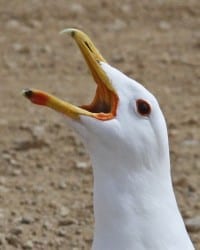 Next up to Walden, crossing the continental divide at Rabbit Ears Pass, and a late afternoon at Walden Reservoir with lots of waterfowl and a particularly garrulous (and hungry) group of handsome adult California Gulls who enjoyed our offering of some handouts of rolls left over from breakfast.
Next up to Walden, crossing the continental divide at Rabbit Ears Pass, and a late afternoon at Walden Reservoir with lots of waterfowl and a particularly garrulous (and hungry) group of handsome adult California Gulls who enjoyed our offering of some handouts of rolls left over from breakfast.
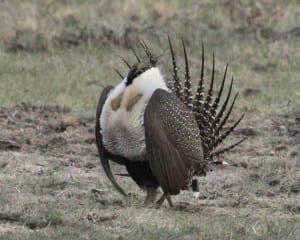 April 16 – day 10: Last day, last lek, this time Greater Sage-Grouse. Another early morning, though not as freezing cold. Again we were on-site before sunrise and as the first light broke we could easily make out many grouse on the lek quite close to the vans, but all of a sudden a very bright light suddenly flashed on, flushing all the birds which flew off into the deep grass some sixty yards away on the opposite side of the road where they were now not only far away, but also directly in the bad light of the sun. What on earth had happened? A group
April 16 – day 10: Last day, last lek, this time Greater Sage-Grouse. Another early morning, though not as freezing cold. Again we were on-site before sunrise and as the first light broke we could easily make out many grouse on the lek quite close to the vans, but all of a sudden a very bright light suddenly flashed on, flushing all the birds which flew off into the deep grass some sixty yards away on the opposite side of the road where they were now not only far away, but also directly in the bad light of the sun. What on earth had happened? A group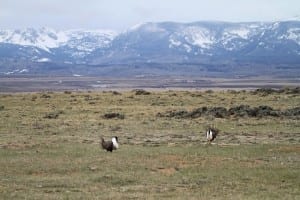 of British birders in another van behind us had managed to accidentally turn on their bright halogen headlights and couldn’t figure out how to turn them off. We were all dumbfounded, disappointed, frustrated, and yes a bit angry, but there was nothing to do but patiently wait, and…by and by, lo and behold, the birds began to work their way back, closer and closer to the road, and finally crossing back over to where they had started – back in perfect light. So it all turned out well in the end, and we had a splendid view of Greater Sage Grouse lek behavior. (video) However we were still temporarily accosted by a zealous state wildlife official who had witnessed the entire fiasco and was taking pictures of all the vans, not realizing that the British group was a separate group and not part of ours. It all finally got sorted out, but the undeserved knee-jerk “guilty until proven innocent” treatment was no doubt a bit disconcerting to our leaders to say the very least.
of British birders in another van behind us had managed to accidentally turn on their bright halogen headlights and couldn’t figure out how to turn them off. We were all dumbfounded, disappointed, frustrated, and yes a bit angry, but there was nothing to do but patiently wait, and…by and by, lo and behold, the birds began to work their way back, closer and closer to the road, and finally crossing back over to where they had started – back in perfect light. So it all turned out well in the end, and we had a splendid view of Greater Sage Grouse lek behavior. (video) However we were still temporarily accosted by a zealous state wildlife official who had witnessed the entire fiasco and was taking pictures of all the vans, not realizing that the British group was a separate group and not part of ours. It all finally got sorted out, but the undeserved knee-jerk “guilty until proven innocent” treatment was no doubt a bit disconcerting to our leaders to say the very least.
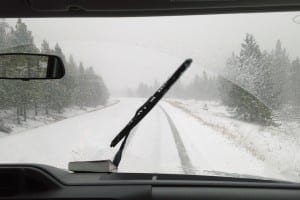 The remainder of the day consisted of a high-elevation drive eastward through State Forest State Park, over Cameron Pass, and finally down to lower elevation and ultimately back to Denver. We were lucky. The weather had been perfect every day until we now experienced treacherous, near white-out driving conditions in the high mountains, and Cameron Pass itself was to receive twenty inches of snow in the ensuing 24 hours. Had we been a day later we could have been stranded in Walden, unable to get back to Denver, and likely would all have missed our flights home.
The remainder of the day consisted of a high-elevation drive eastward through State Forest State Park, over Cameron Pass, and finally down to lower elevation and ultimately back to Denver. We were lucky. The weather had been perfect every day until we now experienced treacherous, near white-out driving conditions in the high mountains, and Cameron Pass itself was to receive twenty inches of snow in the ensuing 24 hours. Had we been a day later we could have been stranded in Walden, unable to get back to Denver, and likely would all have missed our flights home.
